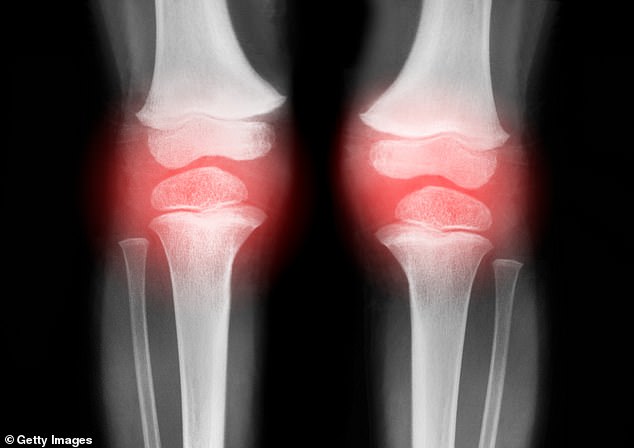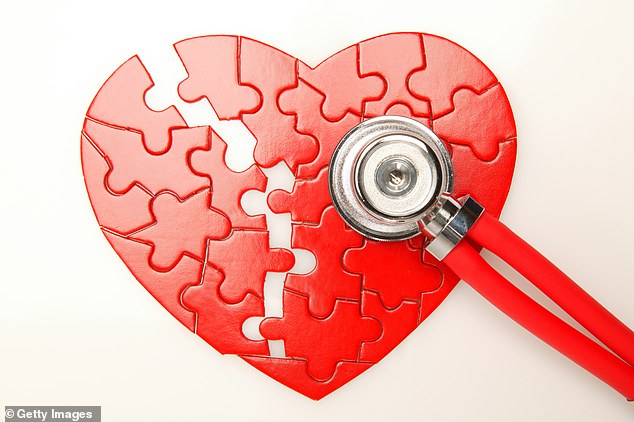My knees turn purple when I sit for too long, but I don't know why: ask the doctor DR. MARTIN SCURR
Q: WHEN I get up in the morning or have been sitting for a while, my knees are purple. What could be the cause? I also have cardiac arrhythmias (an irregular heartbeat), which has resulted in a mini-stroke that has affected my vision, voice and mobility.
Peter Manley, Long Sutton, Lincs.
A: I understand your concern, but this is nothing to worry too much about; it is related to your overall cardiovascular problems.
The symptom you describe is cyanosis: blue discoloration of the skin due to low oxygen levels in the blood. (It's worth noting that deoxygenated blood isn't actually blue; it just looks less bright through the skin than oxygenated blood.)
As a standalone symptom, it can be a sign of heart failure, in which the heart does not pump blood efficiently, reducing the amount of oxygen in the blood moving through your body; it can also cause bluish nails and lips.
However, your cyanosis is not unexpected because it is due to atrial fibrillation (AF), the most common type of heart rhythm disorder.

Low cardiac output can affect circulation in your legs, causing cyanosis in the knees
In AF, abnormal electrical activity in the heart means that the two atria (the upper chambers of the heart) no longer contract in a coordinated manner to pump blood through a valve to the left ventricle (one of the two larger, lower chambers). ).
This oxygen-rich blood must be distributed throughout the body from the left ventricle. But AF means it tends to collect and clot in the atria. This increases the risk of a clot traveling to the narrower blood vessels around the brain and causing a blockage and stroke.
For this reason, patients with AF are prescribed anticoagulants ('blood thinners') to minimize the risk of clots.
Normal heart function can also be restored by applying an electric shock to the heart, called cardioversion; or by ablation, which uses heat to destroy cells in the atria that generate the abnormal electrical signals. In your longer letter you mention that you have had both procedures, but neither completely resolved the problem.
When AF has been present for some time, the muscle of the atrial walls becomes 'remodeled', making it more difficult to correct the error. I suspect this is the case with you.
Unfortunately, the blood thinning treatment also appears to have failed, hence your stroke. Additionally, low cardiac output affects circulation in your legs, causing cyanosis in your knees. In itself, cyanosis is not a symptom you need to worry too much about and is a result of your overall heart health, rather than a separate condition. But if your AF worsens and causes other symptoms such as shortness of breath, especially at rest, see your cardiologist as soon as possible.


If your knees turn purple, it could be a sign of heart failure, where the heart does not pump blood efficiently
Q: I'm in my late 30s and have no children, yet I often have to run to the bathroom without warning because of embarrassing leaks.
Name and address provided.
A: I feel for you, it sounds like your life is dominated by unpredictable incontinence.
While it is true that earlier childbirth or older age are important risk factors (they weaken the bladder muscle and surrounding tissue in the pelvic floor), this is not always the case. In fact, up to 60 percent of women in the reproductive age group – and about 3 percent under the age of 35 – have incontinence at some point in their lives.
The consequences – anxiety, work problems and social isolation – can be serious.
The main types are stress incontinence (leakage due to a sudden increase in pressure in your abdomen, for example from sneezing or laughing) and urge incontinence, when you cannot get there in time.
Your letter shows that you have the latter. It occurs when the bladder muscle becomes irritable, causing spontaneous emptying when it shouldn't.
Obesity is a common cause, but there can also be trauma or damage to the muscle (perhaps caused by an infection). Other factors include drinking too much alcohol or caffeine. Both can irritate the muscle and cause leaking. Urge incontinence is also more common in people with a family history of it.
You should definitely be seen by a specialist after referral from your GP to investigate the causes and find the right remedy. Treatment will likely include supervised physical therapy (to strengthen the pelvic floor) and perhaps medication to calm the irritable bladder muscle.
In my eyes… What you eat is crucial
'YOU ARE what you eat' is undoubtedly important, but should we also add 'and when you eat it'?
Research among 100,000 people in France, whose eating habits were monitored for seven years, found that every one-hour delay (after 8 a.m.) in breakfast increased the risk of cardiovascular disease by 6 percent. Eating after 9 p.m. increases the risk of stroke by 28 percent, compared to eating before 8 p.m. But why?
Researchers think it has to do with cortisol, a hormone secreted by the adrenal glands (peaking in the morning). Cortisol affects our sensitivity to another crucial hormone, insulin, which helps control blood sugar levels.
The theory is that this cortisol peak makes our bodies better able to process food loads early in the day – and coordinating our diet with this peak could reduce our risk of insulin resistance (a precursor to type 2 diabetes) and the chance of can reduce insulin resistance (a precursor to type 2 diabetes). cardiovascular health.
